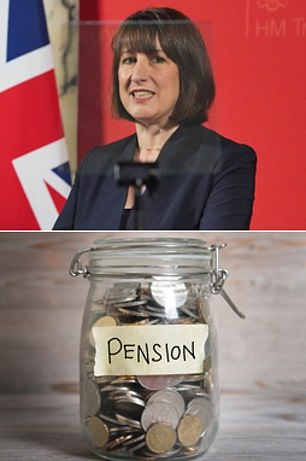Table of Contents
Chancellor Rachel Reeves: Labour has not said anything so far to suggest it plans to reform pension tax relief
Pension tax relief refunds any tax you have paid on your contributions to your fund, so you can get back to square one.
The current system favors the wealthiest because they pay more taxes.
Speculation that Chancellor of the Exchequer Rachel Reeves will consider reforming pension tax (including a flat rate) has prompted warnings of a potential impact on the pensions of six million higher earners.
Other drawbacks being aired include the impact on economic growth if less is invested, a clash with salary sacrifice contributions and complications with final salary pensions – which could even spark public sector strikes.
Tom Selby, director of public policy at AJ Bell, explains whether a restructuring is likely under a Labour government and how it could affect pension savers.
The possibility of an assault on retirement savings incentives is a rumour that often circulates before a Budget.
As things stand, pension contributions benefit from tax relief at their “marginal rate”, meaning basic rate taxpayers get 20 per cent, higher rate taxpayers 40 per cent and additional rate taxpayers 45 per cent.
To limit the cost of tax relief to the Treasury, most people have an annual allowance of £60,000, although those who have flexibly accessed their pension and those on very high incomes have a smaller allowance.
In addition, there are limits on the lump sums that people can transfer from their pensions to their designated beneficiaries when they die.
The most common speculation about pension tax relief ahead of the budget centres on the future of higher rate pension tax relief and the potential for introducing a flat rate of pension tax relief.
At the most extreme, this measure could restrict pension tax relief to the basic rate of 20 per cent for everyone, with proponents suggesting this could generate billions of pounds of extra revenue for the Treasury.

Tom Selby: Introducing a flat rate of relief is much easier said than done
However, as with most radical changes to pension tax, introducing a flat rate of relief is much easier said than done.
A large part of any potential savings to the Treasury from a raid on pension tax relief would come from defined benefit plans, most of which now reside in the public sector.
If a flat rate of pension tax relief of less than 40 per cent were applied to these schemes, the only way to ensure that the correct level of tax relief was applied to the contributions of higher and additional rate taxpayers would be to impose a tax burden on those members likely to amount to thousands of pounds.
This could therefore lead to heated conflict with NHS staff and civil servants at a time when many public services are already stretched to capacity.
Reducing the initial incentive for people to save in a pension fund would also run counter to the government’s broader efforts to boost long-term investment and risk undermining flagship automatic enrolment reforms.
Moreover, younger people, who are less likely to have benefited from a tax cut at higher rates, may understandably feel aggrieved that a benefit offered to the older generation has been taken away from them.
While reintroducing the lifetime retirement allowance has been ruled out, there remains the possibility that the annual allowance could be tweaked to raise some much-needed cash.
But again, this would be awkward for the broader investment agenda and conflict with this government’s overall mission to create stability.
How would a 30% flat rate affect what people save for their pensions?
They are both the same example, they are just slightly different ways of getting to the answer.
Net payment scheme
If a higher rate taxpayer pays a £1,000 contribution right now, they will automatically get 40 per cent tax relief.
In other words, they don’t pay £400 of income tax that they would otherwise pay.
If a flat rate of 30 per cent tax relief is introduced, they would have to pay £100 in tax to reduce their tax relief to 30 per cent.
So their £1,000 contribution has now “cost” them £700 instead of £600.
On the other side of the equation, a basic rate taxpayer would presumably need to receive an additional £100 of tax relief, possibly through a £100 reduction in the overall tax they pay.
So their contribution has now “cost” them £700 instead of £800.
Source relief regime
In a relief at source scheme, if we assume the tax system is geared to automatically add the full 30 per cent tax relief (rather than the individual having to make a claim to HMRC), then an initial contribution of £700 would be raised to £1,000 through the tax relief.
In other words, they get £300 tax relief – 30 per cent of £1,000.
What happens if I have a self-invested personal pension scheme (Sipp)?
It’s a little tricky to model over time, as when you consider a higher rate taxpayer contributing to a Sipp, they currently get 20 per cent relief automatically and then claim the extra 20 per cent.
If it were moved to 30 per cent, they could still get 20 per cent up front as a pension deposit (depending on how the system works), but then they would simply claim the extra 10 per cent.
So the impact would simply be that they could recover a little bit less tax than they currently do.
Some links in this article may be affiliate links. If you click on them we may earn a small commission. This helps us fund This Is Money and keep it free to use. We do not write articles to promote products. We do not allow any commercial relationships to affect our editorial independence.


